October 13th, 2011
Hello Readers. This month’s updates include some exciting stories and exhibits.
Shape-Shifting Tanuki in Japanese Artwork
http://www.onmarkproductions.com/html/tanuki.shtml
Grab you favorite beverage, sit back, and join me on a riotous visual romp featuring over 150 photos (from the 17th century onward) of the magical shape-shifting Tanuki. This 34-page article explores the metamorphosis of the spook-beast Tanuki from bad guy to good guy, from feared to beloved. It also debunks widespread misinformation about Tanuki, his sake flask, promissory note, and giant scrotum. It is intended as a “primer” for students & teachers of art history and folklore. The only thing missing is popcorn.
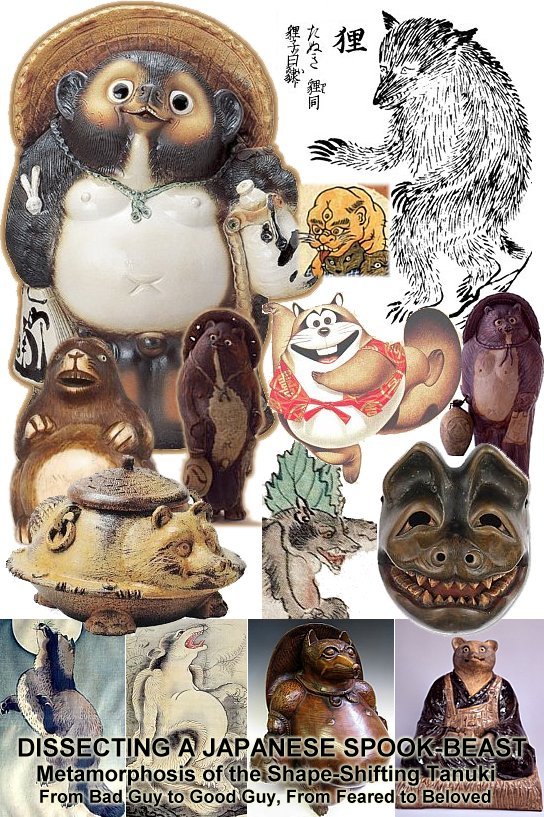
Metamorpohosis of the Shape-Shifting Tanuki, From Bad Guy to Good Guy, Feared to Beloved
Current Exhibitions & In The News
» Aizen Myō-ō Exhibition, October 15 through December 4, 2011
Aizen Exhibition, Kanagawa Bunko. At the Kanagawa Prefectural Kanazawa Bunko Museum 神奈川県立金沢文庫 in Yokohama. If you live in Japan, don’t miss this exhibition, which features Aizen Myō-ō 愛染明王. Aizen is the King of Sexual Passion, one who converts earthly desires (love/lust) into spiritual awakening and saves people from the pain that comes with love. Today, Aizen is also revered in Japan’s gay quarters as the patron of love. Aizen is closely connected with the magical wish-granting jewel (Jp. = Hōjyu 宝珠; Sanskrit = cintamani), as are other Buddhist deities. Depending on the deity involved, the jewel can signify the bestowal of blessings on all who suffer, grant wishes, pacify desires, and bring clear understanding of the Dharma (Buddhist law). In Aizen’s case, worshippers often used the jewel to pray for success in their romantic relationships. One important ceremony was called the Jewel of Aizen Myō-ō Rite 如法愛染王法 (pronounced Nyohō Aizen ō hō). The rite was used in the 13th and 14th centuries by esoteric sects to pray for the love and respect of others. This Aizen rite is a variant of the main esoteric ceremony known as the Wish-Granting Jewel Rite 如意宝珠法 (pronounced Nyoi Hōju Hō). This rite began sometime in the late Heian period, spearheaded by the Daigo-ji Temple (Shingon sect) in Kyoto.
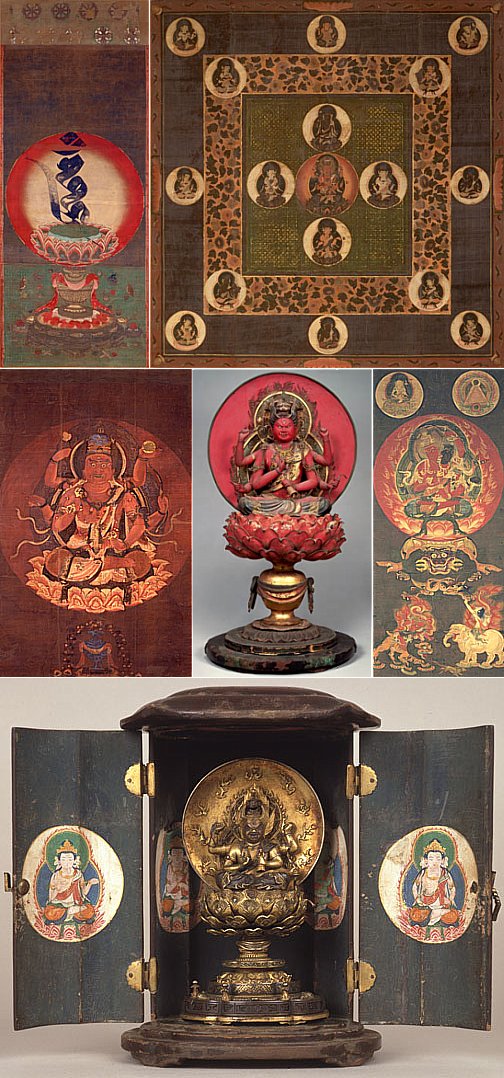
Some of the main Aizen pieces on display, most from the 13th century.
» Kasuga Landscapes & Images of a Sacred Sanctuary, Oct 8 – Nov. 6, 2011
Nezu Museum in Tokyo is holding an incredible exhibition of artwork from Kasuga Shrine (Nara) with approximately 35 paintings, mandalas, and decorative art works. See Nezu Museum’s English page for details.
» Sculptures of the Imperial Household, Until Nov. 20, 2011
Kiyomizu Sannenzaka Museum (Kyoto). Showcases around 60 pieces, including ivory and wooden sculptures, framed carvings and netsuke by Koun Takamura (1852-1934) and Komei Ishikawa (1852-1913), two master sculptors appointed as artists to the Imperial Household when the system started in 1890.
» True living temples: Explore beyond Kyoto’s museum-like big attractions
Special to The Daily Yomiuri Read the story here.
» Robert Yellin, Handling History in a Clay Vessel
Read the story here.
Please enjoy this month’s newsletter.
mark from kamakura
Posted in Aizen, Tanuki, Uncategorized | No Comments »
August 28th, 2011
Hello Readers,
Lots to report this month.
Kamakura Bonbori Festival
https://onmarkproductions.com/html/bonbori.html
Enjoy nearly 140 photos of paper lantern artwork. Bonbori 雪洞 is a Japanese paper lantern. In August each year, bonbori lanterns are lit in the sacred precincts of the Tsurugaoka Hachimangu Shrine in central Kamakura city. Other cities around Japan have similar lantern festivals. In Kamakura, lanterns are submitted by many artists, novelists and famous people. Roughly 400 bonbori with hand-drawn pictures, calligraphy, and poems are displayed in the shrine’s precincts during the festival.
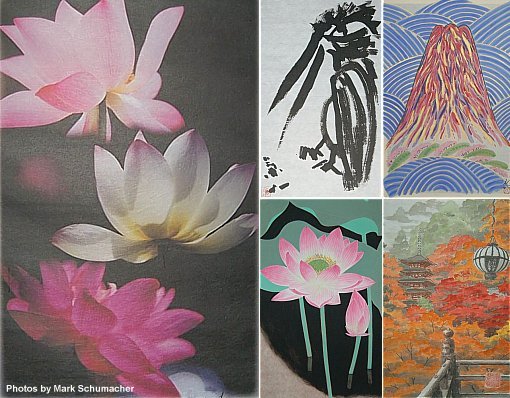
Some of the Bonbori artwork in Kamakura 2011. Click image for slideshow.
Becoming a Shintō Priest or Priestess
To work officially as a priest in modern Japan, individuals must pass examinations given by the Association of Shintō Shrines (Jinja Honchō神社本庁) — these tests are open to both men and women who want to become Shintō priests. But until modern times, there was no standardized certification or qualification system. Throughout most of Japan’s recorded history, appointments to the priesthood were controlled by the imperial court, priestly family lineages, and various Shintō schools. Essentially, the Shintō priesthood was a hereditary profession — passed along from father to son — until the Meiji Era (1868-1912). On 14 May 1871, the Meiji government issued orders abolishing the hereditary system and private ownership of shrines. Theoretically, these ordinances should have eradicated the hereditary system, but in practice, priests were still able to inherit their positions by applying for and receiving the approval of authorities. Before World War II, it was virtually unheard of for a Shinto priest to be a woman. World War II apparently gave a boost to female priests, with wives and daughters replacing the missing menfolk. Also, today, with the lack of interest in religion, and with families growing smaller, shrine priesthoods have had to open up to daughters to keep the priesthood in the family.
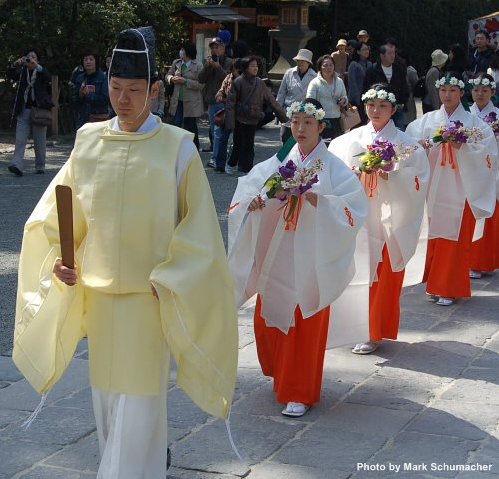
Shinto priest & miko (female attendants) at Tsurugaoka Hachimangu in Kamakura
Current Exhibitions & In The News
» Tokyo National Museum. July 20 through September 25, 2011 . Kukai’s World: The Arts of Esoteric Buddhism. If you are in or near Tokyo, don’t miss this exhibition. I recently attended this exhibition. What a splendid experience. The 99 pieces (of which 98 are national treasures or ICPs) came primarily from Toji Temple. What a delight. And this time the museum got innovative — many of the pieces could be enjoyed “in the round,” letting viewers walk behind the pieces to view the multiple heads and hanging robes and platforms in their entirety. This exhibition introduces masterpieces of Shingon Esoteric Buddhism, with a focus on the objects brought by Kukai from Tang China; works directly related to him (such as his writings and sculptures produced under his instruction). Even Tendai’s much neglected Saicho makes an appearance (calligraphic scroll). Due to massive PR efforts, this exhibition is extremely popular. The place was packed on Wednesday (when I visited), requiring one to wait patiently in line to view the 99 pieces. It is also OBON here, so that too explains the multitude. It took me and my friend (an esoteric practitioner) over three hours to complete the circuit — nonetheless, it was extremely impressive.
» Kyoto National Museum. July 16 to August 28, 2011. Now Ended.
Creatures’ Paradise: Animals in Art from the Kyoto National Museum.
See review of this exhibit entitled Japan’s interpretation of all creatures great and small.
By SACHIKO TAMASHIGE. Special to The Japan Times.
» Nara National Museum. Special Exhibitions Page. On to India! Xuanzang’s 30,000-Kilometer Trek. July 16 through August 28, 2011. Secret Treasures & Sacred Image of Yoki Tenman Jinja: “The Hallowed Yoki Shrine at Hatsuse.” July 16 through August 28.
» Bronze sculptures by UK artist Sukhi Barber
https://sukhibarber.com. She spent twelve years in Kathmandu (Nepal) studying Buddhist philosophy and lost-wax bronze casting.
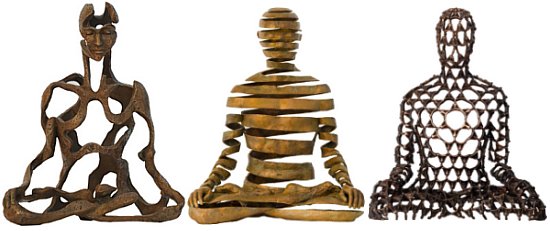
UK artist Sukhi Barber
» Japanese brothers who championed Korean ceramics.
By SACHIKO TAMASHIGE. Special to The Japan Times
https://search.japantimes.co.jp/mail/fa20110825a1.html
» Buddhist Art News https://buddhistartnews.wordpress.com
News on Buddhist art, architecture, archaeology, music, dance, and academia.
Written and updated regularly by Jonathan Ciliberto and John Johnston. Includes
reviews of new books related to Buddhist art.
» IBM helping National Diet Library of Japan digitize its literary artifacts on massive scale. https://rdmag.com/News/Feeds/2011/08/information-tech-ibm-develops-full-text-digitization-system-for-nat/
» Mask maker keeping Shimane tradition alive | The Japan Times Online
Englishman’s skills help sustain 17th-century Iwami-Kagura ceremonial dance rituals.
https://search.japantimes.co.jp/mail/fl20110827a1.html
» 1893 expo’s historic Japanese Phoenix panels reunited, restored.
https://southtownstar.suntimes.com/7068303-522/1893-expos-historic-japanese-panels-reunited-restored.html
Enjoy
mark from kamakura
Posted in Bonbori, Shinto Topics, Uncategorized | No Comments »
July 27th, 2011
Hello Readers,
Knowledge Updates for July 2011. This month the newsletter is “abbreviated,” as I’m visiting my hometown in steamy Minnesota.
A Modern Day Miracle?
Six Jizō and the Killer Tohoku Earthquake.
In the wee hours on the morning following the March 11 Tohoku earthquake, aftershocks struck the northern part of Nagano Prefecture, causing an outdoor grouping of Six Jizō statues in Iiyama City 飯山市 to shift their position. Originally facing south, the statues turned about 90 degrees to the east, in the direction of nearby Sakae-mura village 栄村, as if to protect the villagers from harm. Indeed, Sakae-mura itself experienced three aftershocks in less than two hours, each about intensity 6.0. Village roads and railways were damaged, and over 2000 villagers were evacuated. But there were no causalities!! Not surprisingly, villagers say that Jizō saved them from bodily harm. The statues are each about 70 cm high, made of stone. There are actually seven Jizō in the grouping, but the first Jizō (the leader) did not change his position, whereas the other six turned on their bases to face Sakae-mura. Today they are venerated as protectors of the village, even though they are located in nearby Iiyama. (Note. Thanks to my longtime friend Gabi Greve for bringing this story to my attention. The story appeared originally in the Asahi Shimbun (June 9, 2011).
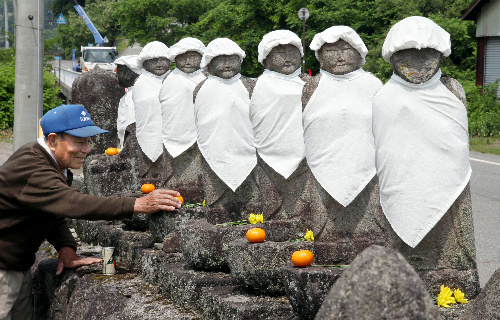
The first Jizō (the leader) did not shift; the other six turned to face Sakae-mura.
More about Roku Jizō 六地蔵 (lit. = Six Jizō)
Six Jizō and Six States of Existence. Jizō Bosatsu vowed to assist beings in each of the
Six Realms of Desire and Karmic Rebirth, in particular those in the hell realm, and is thus often shown in groupings of six. In Japan, groupings of six Jizō statues (one for each of the Six Realms) are quite common and often placed at busy intersections or oft-used roads to protect travelers and those in “transitional” states. Jizō also often carries a staff with six rings, which he shakes to awaken us from our delusions. The six rings likewise symbolize the six states of desire and karmic rebirth and Jizō’s promise to assist all beings in those realms. Worship of the Six Jizō can be traced back to the 11th century in Japan, but this grouping has no basis in Mahayana scripture. Its origin is probably linked to a similar grouping of
Six Kannon (one for each of the six realms) that appeared in the early 10th century in Japan’s Tendai 天台 sect.
Six Realms (from lowest to highest, from worst to best)
- Hells (Skt. Naraka, Jp = Jigokudō 地獄道)
- Hungry Ghosts (Skt. Preta, Jp = Gakidō 餓鬼道)
- Animals (Skt. Tiryasyoni, Jp = Chikushōdō 畜生道)
- Bellicose Demons (Skt. Asura, Jp = Ashuradō 阿修羅道)
- Humans (Skt. Manusya, Jp = Jindō 人道)
- Heavenly Beings (Skt. Deva, Jp = Tendō 天道)
Japanese Ceramics &
Robert Yellin Yakimono Gallery in Kyoto
It gives me great pleasure to introduce the world-class ceramics gallery of longtime friend and ceramics connoisseur Robert Yellin. Just a few minutes walk from the Silver Pavilion in Kyoto, this gallery is located in a magical Showa-period Sukiya-style house built for a wealthy tea and kendo patron. In later years, it was the residence of Tea Master John McGee, who returned to Canada to create a
Tea room and center. The spirit of Tea and wabi-sabi pervades the house and as such is the perfect stage for the many shibui ceramic art works offered by Yellin. In addition, the house (and its garden) act as the perfect stage for presenting new works online at
Japanesepottery.com. If you visit the gallery, please say “Schumacher sent you” to receive a special discount on listed prices. Yellin is a longtime Japan resident, pottery journalist, and ceramic specialist who collects and sells pieces by some of Japan’s most celebrated artists and up-and-coming potters. Robert also operates an online learning center devoted to Japanese pottery at
http://www.e-yakimono.net
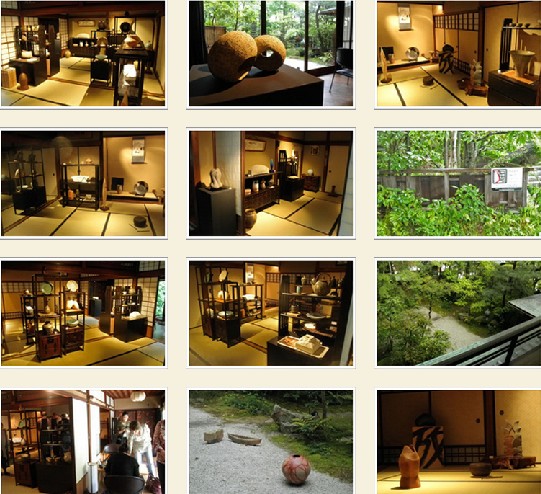
Robert Yellin Yakimono Gallery – Photo Tour
Current Exhibitions
» Tokyo National Museum. July 20 through September 25, 2011 . Kukai’s World: The Arts of Esoteric Buddhism. This exhibition introduces masterpieces of Shingon Esoteric Buddhism, with a focus on the period when philosophical elements maintained a strong presence in the works. Along with objects brought by Kukai from Tang China, works directly related to him are also featured, such as his writings and sculptures produced under his instruction. If you are in or near Tokyo, don’t miss this exhibition.
» Kyoto National Museum. July 16 to August 28, 2011.
Creatures’ Paradise: Animals in Art from the Kyoto National Museum.
» Nara National Museum. Special Exhibitions Page. On to India! Xuanzang’s 30,000-Kilometer Trek. July 16 through August 28, 2011. Secret Treasures & Sacred Image of Yoki Tenman Jinja: “The Hallowed Yoki Shrine at Hatsuse.” July 16 through August 28.
Enjoy the summer.
mark from his hometown in minnesota
Posted in Jizō, Uncategorized | No Comments »












